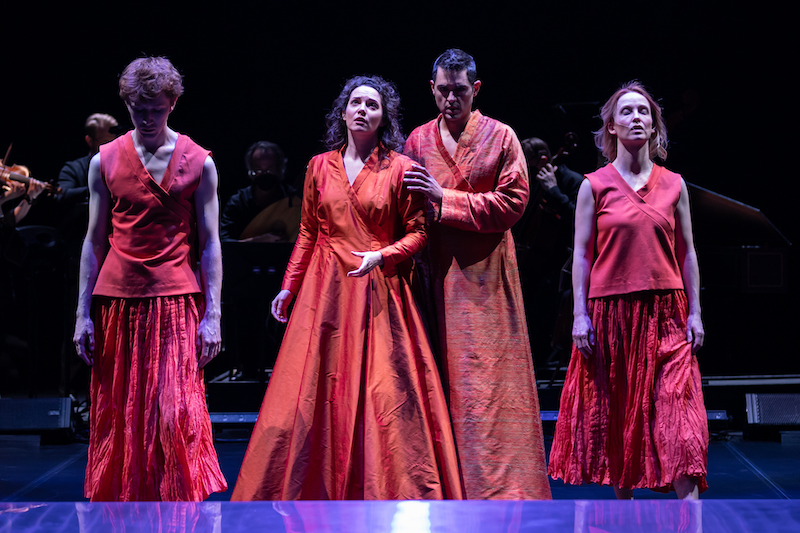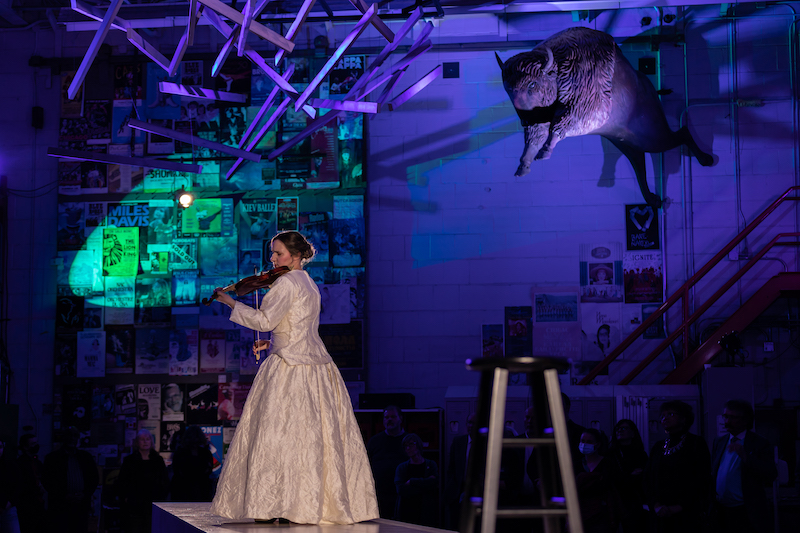Edmonton Opera wrapped its 59th season with four intimate performances of an apt sacred work on the cusp of the Christian Holy Week. Artistic director Joel Ivany programmed Pergolesi’s 1736 treatment of the 13th-century hymn Stabat Mater to cap off his first full season in charge. The soprano and the countertenor in the performance sang in subdued operatic style, but the Edmonton opera season did not end with an opera; the effect, if small scale, was musically powerful, though. Stabat Mater was presented in a makeshift, cozy black box theatre on the auditorium’s actual stage. Each of the sold-out performances had a capacity of just 327 listeners, who sat in chairs on risers, lining two sides of a black platform where some of the ‘action’ took place. The auditorium, itself, holds more than 2,000 for a Tosca or a Bohème, but it was dark. A small, early music ensemble accompanied from one end of the small performance space. Ivany has developed some of his aesthetic in unoperatic spaces. His Against the Grain Theatre company has offered opera and other types of programs, including a unique take on Handel’s Messiah, in pubs and other unconventional locations. He made his concert directorial debut staging Mozart’s Requiem with the Toronto Symphony Orchestra, so he’s not unfamiliar with the theatrical potential of otherwise non-operatic repertoire. He wasn’t the director of this program, but it was his idea. Jennifer Tarver directed traffic, along with choreographer Susanna Hood, but he saw a beautiful, churchy work as an offering his audience would appreciate, and on the final performance April 1, they certainly did.
To enhance the dramatic potential of a work composed for a staid spiritual ritual, a male and female dancer (Max Hanic and Amber Borotsik) moved about the space, often interweaving among the singers, sometimes in mid vocal phrase. I found them distracting at times (Pergolesi might be enough normally). But in tableaux where they posed as though to comfort the soprano channeling the sorrowful mother’s unbearable pain, in these moments, the inclusion of other empathetic bodies on the stage was touching and made
good sense. Most of the twelve movements are mainly about Mary’s grief, her son’s agony, and the worshippers’ willingness to bear the same sorrow as the emblems of Christian forbearance and faith, themselves. But not all the music is dark, even when the words speak only of anguish, weeping and lamentation, something conservative churchman criticized Pergolesi for in his time.

© Nanc Price
Wednesday, May 17, 2023 at 6pm
Women’s Art Association, Toronto, ON
An Event To Support Opera Canada
TICKETS HERE
Mireille Asselin has sung on big stages such as the Metropolitan Opera and the Canadian Opera Company’s Four Seasons Centre, but in the space where she could make eye contact with the audience, she gave a beautifully reserved, reverential portrayal of a woman empathizing profoundly with the central figure of the hymn’s narrative. In the few movements where the mood was more uplifting, such as the penultimate “Inflammatus et accensus”, she and her partner, countertenor Magid El-Bushra, sang the joy of the believer imagining a reunion with the blessed mother and their saviour buoyantly. The work is a story of Catholic devotion to abiding motherhood, and both singers did an excellent job of playing the roles of detached sermonizers and devotees themselves. The singers were making their Edmonton Opera debuts.
Before the main event, the ticket-holders congregated in the Jubilee lobby, where Ivany explained the unconventional format of the evening. Then everyone was herded into the back of the building through narrow halls onto the loading dock, where a catwalk-type platform was set up, and at one end sat violinist Chloe Meyers, dressed in a billowing white, floor-length gown. Once the crowd settled, most of them standing, Meyers played a 12-minute Passacaglia from the Rosary Sonatas by Heinrich Biber, a piece that conjures stillness in subtle lines of musical variation. As she played, she intermittently glided along the long platform, until she reached the other side, setting a meditative mood as a prelude to the following 40-minute Stabat Mater.
Edmonton Opera is on a path toward redefining what an opera company means. This Stabat Mater hinted at the open-ended notion of high vocal art that Edmonton audiences can look forward to.
Related Content ⬇
Opera Canada depends on the generous contributions of its supporters to bring readers outstanding, in-depth coverage of opera in Canada and beyond. Please consider subscribing or donating today.
EDMONTON OPERA
MAR 30 to APR 1
PERGOLESI STABAT MATER
CAST AND CREATIVE TEAMS
Musical Director and Soloist Chloe Meyers
Director Jennifer Tarver
Choreographer Susanna Hood
Scenery and Costume Designer Teresa Przybylski
Lighting Designer Bretta Gerecke
Head Coach & Répétiteur Frances Thielmann
Countertenor Magid El-Bushra
Soprano Mireille Asselin
Dancer Amber Borotsik
Dancer Max Hanic
Violin Chloe Meyers
Lute Sylvain Bergeron
Viola Keith Hamm
Cello Rafael Hoekman
Harpsicord & Organ Christina Huttenv
Violin Laura Veeze
Violone Josephine van Lier
Stage Manager Anna Davidson
Assistant Stage Manager Hunter Luth
Assistant Stage Manager Donna Sharpe
Assistant Stage Manager Elizabeth Schieman
Apprentice Stage Manager Kahlan Oosterveld












